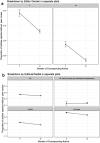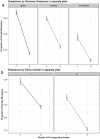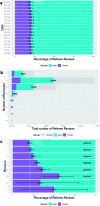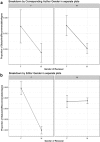Is there a gender gap in chemical sciences scholarly communication?
- PMID: 32180933
- PMCID: PMC7057853
- DOI: 10.1039/c9sc04090k
Is there a gender gap in chemical sciences scholarly communication?
Abstract
The Royal Society of Chemistry is committed to investigating and addressing the barriers and biases which face women in the chemical sciences. The cornerstone of this is a thorough analysis of data regarding submissions, review and citations for Royal Society of Chemistry journals from January 2014 until July 2018, since the number and impact of publications and citations are an important factor when seeking research funding and for the progression of academic career. We have applied standard statistical techniques to multiple data sources to perform this analysis, and have investigated whether interactions between variables are significant in affecting various outcomes (author gender; reviewer gender; reviewer recommendations and submission outcome) in addition to considering variables individually. By considering several different data sources, we found that a baseline of approximately a third of chemistry researchers are female overall, although this differs considerably with Chemistry sub-discipline. Rather than one dominant bias effect, we observe complex interactions and a gradual trickle-down decrease in this female percentage through the publishing process and each of these female percentages is less than the last: authors of submissions; authors of RSC submissions which are not rejected without peer review; authors of accepted RSC publications; authors of cited articles. The success rate for female authors to progress through each of these publishing stages is lower than that for male authors. There is a decreasing female percentage when progressing through from first authors to corresponding authors to reviewers, reflecting the decreasing female percentage with seniority in Chemistry research observed in the "Diversity landscape of the chemical sciences" report. Highlights and actions from this analysis form the basis of an accompanying report to be released from the Royal Society of Chemistry.
This journal is © The Royal Society of Chemistry 2020.
Figures
































References
-
- Diversity landscape of the chemical sciences, https://www.rsc.org/globalassets/02-about-us/our-strategy/inclusion-dive..., accessed March 2019.
-
- Breaking the barriers, http://www.rsc.org/campaigning-outreach/campaigning/incldiv/inclusion--d..., accessed March 2019.
-
- Gender in the Global Research Landscape, https://www.elsevier.com/__data/assets/pdf_file/0008/265661/ElsevierGend..., accessed March 2019.
-
- Nature's sexism, Nature, 2012, 491, 495. - PubMed
-
- Bias revisited, Nature,2018, 558, 344.
LinkOut - more resources
Full Text Sources
Miscellaneous

